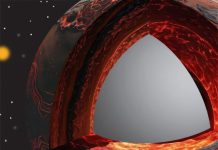
Scientists from UC San Diego’s Scripps Institution of Oceanography have uncovered new information about the “Fagradalsfjall Fires,” the volcanic eruptions that began on Iceland’s Reykjanes peninsula in 2021.
By studying the lava from these eruptions, they found that large amounts of magma were pooling just beneath the surface before the eruptions began.
The researchers, led by Scripps Oceanography geologist James Day, analyzed the geochemical signals from the lava.
They found that the eruptions started with massive magma pooling, challenging the previous idea that magma came straight from deep within the Earth.
The study, published in the journal Nature on July 31, showed that by collecting lava samples at regular intervals and measuring their composition, scientists could understand what was happening beneath the volcano.
Dr. Day compared this to taking regular blood samples from a person to monitor their health, with the lava being the volcano’s “blood.”
Day and his team, including international colleagues and students from Scripps Oceanography, have also been studying basaltic lavas from other recent eruptions, such as the 2021 eruption of the Tajogaite volcano on La Palma in the Canary Islands and the 2022 eruption of Mauna Loa in Hawai’i. They found evidence of similar magma pooling beneath La Palma, suggesting this might be a common process in large basaltic eruptions.
The researchers discovered a significant signal of the Earth’s crust in the earliest lavas from the Iceland eruption. This finding, along with their studies from La Palma, suggests that magma storage in the crust may be a common occurrence before large basaltic eruptions. This information could be crucial for understanding and predicting volcanic hazards in the future.
Previously, scientists thought the Fagradalsfjall Fires erupted without any interaction with the crust. However, Day’s team used the isotopic composition of the element osmium to understand what was happening beneath the volcano. Osmium isotopes are highly sensitive to the crust and revealed that the early lavas were contaminated by crustal material.
The team analyzed lavas from the 2021 and 2022 eruptions of the Fagradalsfjall volcano. They found that the 2021 lavas were contaminated by crust, while the 2022 lavas were not. This suggests that the earliest lavas pooled in the crust, and this interaction may have helped trigger the eruption.
Dr. Day and his colleagues plan to continue studying Iceland’s volcanic activity. Previous eruptions on the Reykjanes peninsula have lasted for centuries, indicating that volcanic activity there is likely to continue for a long time. Dr. Day expressed his excitement, saying, “The eruptions in Iceland will outlast me, but they will provide a treasure trove of important scientific information on how volcanoes work and their associated hazards.”
Besides James Day and Savannah Kelly, other researchers involved in the study include Geoffrey Cook of Scripps Oceanography, William Moreland and Thor Thordarsson from the University of Iceland, and Valentin Troll from Uppsala University in Sweden.



